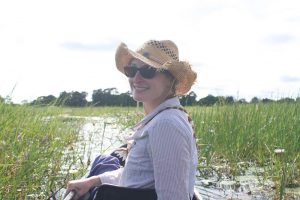By, Bonnie McGill, PhD candidate and LTER researcher in Professor Steve Hamilton’s Lab, W.K Kellogg Biological Station, Michigan State University
~~~~

Bonnie McGill in a mokoro (canoe) in the Okavango Delta, Botswana.
Nitrate, dead zone, Midwest, agriculture—you know where this is headed. Here I’m going to explain a new project I will soon embark on for my postdoctoral work where I will try to improve our understanding of how voluntary conservation practices on farms in Iowa affect the nitrate concentrations in Iowa streams and rivers. The mammoth amount of previous work, complexity, and controversy around this issue is not lost on me. The issue of fertilizer nitrogen driving the dead zone in the Gulf of Mexico has long haunted biogeochemists, Midwestern farmers, Louisiana fishermen, and environmental regulators. Some people become astronauts because they want to go to outer space. Others become biogeochemists because they want to reduce the size of the dead zone. Or at least that’s why I did. So the opportunity to work on this very problem is a humbling privilege and quite daunting. What new thing can I possibly contribute to this well-studied problem?
Apparently the folks who run the David H. Smith Conservation Research fellowship program think I can do something, because they have awarded me one of their competitive fellowships to work on this. My project title is “Farming for a smaller dead zone: How agricultural conservation practices, artificial drainage, and climate change affect water quality in Iowa”. I will be working with Drs. Amy Burgin and Terry Loecke at the University of Kansas. They are former KBS LTER grads (!) who focus on aquatic nutrient cycling and soil carbon cycling, respectively, in agricultural landscapes. They have amassed a novel dataset covering about 10 years of measurements from in-stream nitrate sensors in 60 sub-watersheds across Iowa. These sensors measure the nitrate concentration every 15 minutes, which provides much higher resolution than previous records at the weekly or monthly scale. This resolution will allow us to more closely tie patterns in nitrate concentrations (and load) over time to specific climate and management events.

Example of one of the beautiful Iowa streams that will be monitored. Photo credit, Flicker user Carl Wycoff.
I will also collaborate with Dr. W. Dean Hively at the US Geological Survey. He will help me analyze satellite imagery to quantify visible conservation practices like no-till, winter cover crops, and riparian buffers in these Iowa sub watersheds. We will use the USDA’s Soil Water Assessment Tool (SWAT), a watershed model, to test how the conservation intensity of these watersheds influences the nitrate concentration in these streams over time.
Getting back to my question of what can I contribute: this will be the first study to assess the efficacy of these conservation practices at a regional scale using real nitrate measurements. This is important for several reasons. First, tax payer dollars fund the incentive programs that pay farmers to implement many of these conservation practices. Taxpayers should get the most bang for their buck, but currently we do not have an understanding of how to prioritize Farm Bill spending to have the greatest effect on reducing stream nitrate. Hopefully, my work will shed some light on this.
Second, we are also currently unable to predict how climate change will affect how these conservation practices do or don’t reduce nitrate pollution in streams. Amy and Terry have already shown how “weather whiplash”, a drought summer followed by an unusually wet spring like in 2012 and 2013, significantly increased river nitrate loads in the Upper Mississippi River Basin. These abrupt changes are predicted to increase in frequency,

Tile drainage in Iowa example. Photo credit, Iowa Public Radio.
potentially exacerbating nutrient pollution issues. I will use the SWAT model to test how nitrate concentrations will change under different future climate and conservation scenarios.
The third reason this project is important is that voluntary conservation practices are our best hope for conserving water quality in US agricultural landscapes. Farms are not currently regulated as point sources of pollution under the Clean Water Act, and given the current political climate, new regulations are not a viable option. Besides, in the words of Aldo Leopold, “Conservation… is a positive exercise of skill and insight, not merely a negative exercise of abstinence or caution.” Most farmers see themselves as stewards of the land, and I think collaborations between scientists and farmers can be mutually beneficial. In this project, I will conduct focus groups and/or interviews with Iowa farmers to elicit their feedback on the design of the future climate and conservation scenarios to test in SWAT. This work will be facilitated by the Practical Farmers of Iowa and the USDA Agricultural Research Service. I hope that this interaction will help ensure the SWAT scenarios reflect the real world. I also hope to explore with farmers how their adoption and/or implementation of conservation practices might change with specific climate change scenarios.

In-stream nitrate sensors in Iowa. Photo credit, Amy Burgin.
Last but certainly not least, Iowa contributes about 10% of the nitrate that reaches the Gulf of Mexico and instigates the dead zone. If we can figure out how to more strategically implement conservation practices on the landscape, we will be one step closer to reducing the size of the dead zone in the Gulf of Mexico. What we learn in Iowa can be applied to the rest of the Corn Belt.
I’m excited to take all that I’ve learned in the Hamilton Lab and at the KBS LTER as I attempt this “moon shot”. No, I’m not going to fix the whole problem. But as I’ve learned at the KBS LTER, I can leverage previous results in new ways, add new information, and, through interdisciplinary collaborations, make important contributions toward understanding and solving big problems.
To learn more about the David H. Smith Fellowship please visit https://conbio.org/mini-sites/smith-fellows.